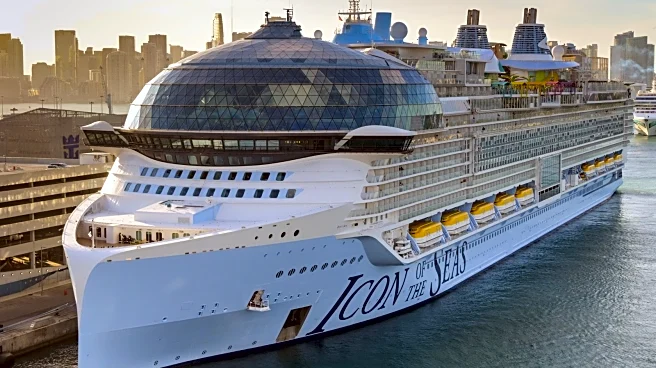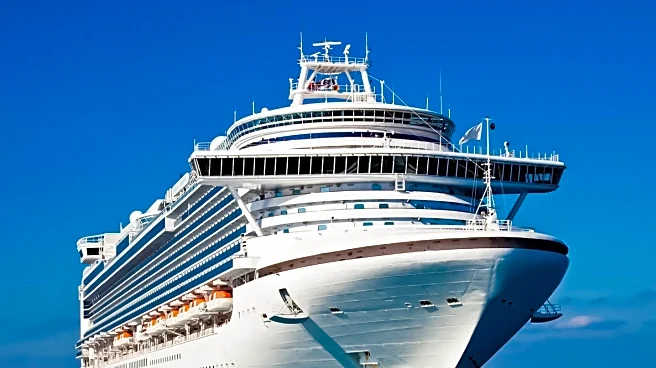
The Icon of the Seas is a big ship. At 1,197 feet long and weighing in at 248,663 gross tonnes, she is the largest cruise ship in the world. She has 20 decks and can hold 7,600 passengers and 2,350 crew members. A ship that size needs some big engines to power it. How big do you think those engines would need to be? Imagine an engine that is roughly the size of a city bus but weighs 10 times more. Now imagine six of those engines lined up deep in the lower decks of the cruise ship.
Enter the Wärtsilä
engines, monster power stations that inhabit the bowels of many of the world's largest cruise ships. They are all well over 30 feet long, and their weights are measured in hundreds of tons. But Wärtsilä isn't the only game in town when it comes to behemoth cruise ship engines. There's also the 16-cylinder Caterpillar MaK engine. This bad boy is even bigger and can crank out 20,710 horsepower or 15.4 megawatts. As unbelievably large as these engines are, they are only part of a ship's power system. They are joined by gigantic thrusters, which move the enormous propellers of these ships. These thrusters can weigh up to 200 metric tons all by themselves.
While these numbers are pretty amazing, they're not surprising. Cruise ships keep getting bigger and bigger, with passenger and crew capacities that are larger than the populations of many small towns. It would take gargantuan engines to power a small town and move it across the ocean.
Read more: These V6 Engines Put The LS1 V8 To Shame
How Big Are These Engines, Exactly?

Wärtsilä is the big name in large cruise ship engines. No fewer than 7 of the 10 largest cruise ships use Wärtsilä engines. The biggest ship, Icon of the Seas, uses six of these behemoths, three with 14-cylinders and three with 12-cylinders. The 12-cylinder engine weighs 203 tons, is about 34 feet long, 15 feet wide, and about 12 feet high. The 14-cylinder is even bigger at 245 tons and almost 40 feet long. That's bigger than the apartments that some of us have lived in.
Oddly enough, the largest cruise ship in the world does not use the largest engine on the market. It doesn't even use the largest Wärtsilä engine. That would be the 16-cylinder version, a giant that is 41 feet long (longer than a standard city bus), over 11 feet wide, almost 17 feet tall, and weighs in at 259 tons. It can slap out an incredible 18,320 kilowatts or about 24,500 horsepower. The 16-cylinder Caterpillar MaK is even bigger. The largest version of this engine is 47 feet long, 11 feet wide, almost 22 feet tall, and weighs 240 tons. The Costa Toscana and Costa Smeralda, each of which is over 1,100 feet long, have four of these engines.
Not to be outdone are the thrusters that are installed in these cruise ships. The Icon of the Seas is fitted with three 20-megawatt Azipod thrusters and five smaller bow thrusters. The propeller alone on the Azipod thruster can have a diameter of 20 feet. The thruster weighs over 200 tons and cranks out 20 megawatts (equivalent to about 27,000 horsepower). Yet, even at its huge size, the Azipod thruster can rotate 360 degrees, eliminating the need for a rudder.
How Much Fuel Do These Engines Use?

Surely such massive engines must use a massive amount of fuel, right? Yes, they do. The Harmony of the Seas, for example, uses 1,377 gallons of fuel per hour when at full power, which equates to about 60,000 gallons a day. Some cruise ships use upwards of 80,000 gallons a day. As you can imagine, using that much fuel results in a lot of harmful emissions, especially when conventional fuel oil is used.
One 2017 European study found that Royal Caribbean Cruises emitted four times more sulfur oxide around Europe's coasts than all of the cars in Europe combined. Carnival did even worse, emitting ten times as much sulfur oxide as European cars. Sulfur oxide contributes to acid rain and can be harmful for humans to breathe in. One team of journalists tested the air on the deck of one cruise ship and found 84,000 ultrafine particles per cubic centimeter, about the same number you'd find in Delhi and Shanghai, and over twice as many as you'd find in central London.
That's why many cruise ships like the Icon of the Seas are being equipped with engines that can run on liquefied natural gas (LNG), instead of conventional fuel oil. Royal Caribbean expects this to reduce sulfur emissions to zero and cut carbon emissions by 70%. Great, right? Well, the use of LNG is a mixed bag, since it often results in the release of methane, which is 80 times more potent than carbon dioxide, straight into the atmosphere. As the size of cruise ships continues to increase, so will their power needs. Cruise companies are taking steps to make their ships greener, but it remains to be seen if these efforts will have a significant impact.
Want more like this? Join the Jalopnik newsletter to get the latest auto news sent straight to your inbox...
Read the original article on Jalopnik.
















